Establishment of a Mass Concrete Strength-Monitoring Method Using Barium Titanate–Bismuth Ferrite/Polyvinylidene Fluoride Nanocomposite Piezoelectric Sensors with Temperature Stability
Abstract
:1. Introduction
2. Principle of the Strength-Detection Approach for Concrete with the BT–BFO/PVDF Nanocomposite Piezoelectric Sensors
3. Specimen Preparation and Test Scheme
3.1. Preparation of BT-BFO/PVDF Nanocomposite Piezoelectric Sensors
3.2. Concrete Specimen
3.3. The Compressive Test and the Strength-Monitoring Test of Concrete Specimens
3.4. Mass Concrete
3.5. Layout of Thermocouples and Piezoelectric Sensors in Mass Concrete
3.6. A Strength-Detection System for Mass Concrete Supported by Piezoelectric Sensors
4. Results and Discussion
4.1. Effort of the Excitation Signal Voltage
4.2. Concrete Specimen Analysis
4.3. Temperature Stability of the BT–BFO/PVDF Piezoelectric Sensor
4.4. Monitoring Accuracy of the BT–BFO/PVDF Piezoelectric Sensor
4.5. Strength-Monitoring Model of Mass Concrete Proposed Using BT–BFO/PVDF Sensors
5. Conclusions
Supplementary Materials
Author Contributions
Funding
Institutional Review Board Statement
Informed Consent Statement
Data Availability Statement
Conflicts of Interest
References
- Le, H.; Vu, C.; Ho, N.; Luu, V. A method of controlling thermal crack for mass concrete structures: Modelling and experimental study. IOP Conf. Ser. Mater. Sci. Eng. 2020, 869, 72054. [Google Scholar] [CrossRef]
- Smolana, A.; Klemczak, B.; Azenha, M.; Schlicke, D. Early age cracking risk in a massive concrete foundation slab: Comparison of analytical and numerical prediction models with on-site measurements. Constr. Build. Mater. 2021, 301, 124135. [Google Scholar] [CrossRef]
- Chen, H.R.; Mardmomen, S.; Leon, G. On-site measurement of heat of hydration of delivered mass concrete. Constr. Build. Mater. 2021, 269, 121246. [Google Scholar] [CrossRef]
- Maruyama, A.; Lura, P. Properties of early-age concrete relevant to cracking in massive concrete. Cem. Concr. Res. 2019, 123, 105770. [Google Scholar] [CrossRef]
- Miller, D.; Ho, N.; Talebian, N. Monitoring of in-place strength in concrete structures using maturity method—An overview. Structures 2022, 44, 1081–1104. [Google Scholar] [CrossRef]
- Kuryłowicz-Cudowska, A.; Wilde, K.; Chróścielewski, J. Prediction of cast-in-place concrete strength of the extradosed bridge deck based on temperature monitoring and numerical simulations. Constr. Build. Mater. 2020, 254, 119224. [Google Scholar] [CrossRef]
- Voutetaki, M.E.; Naoum, M.C.; Papadopoulos, N.A.; Chalioris, C.E. Cracking Diagnosis in Fiber-Reinforced Concrete with Synthetic Fibers Using Piezoelectric Transducers. Fibers 2022, 10, 5. [Google Scholar] [CrossRef]
- Li, G.; Luo, M.; Huang, J.; Li, W. Early-age concrete strength monitoring using smart aggregate based on electromechanical impedance and machine learning. Mech. Syst. Signal Process. 2023, 186, 109865. [Google Scholar] [CrossRef]
- Lv, Z.; Jiang, A.; Tan, Z. Acoustic Emission from Concrete: Critical Slowing Down Analysis and Compressive Strength Prediction. Adv. Mater. Sci. Eng. 2023, 2023, 4483905. [Google Scholar] [CrossRef]
- Karayannis, C.G.; Golias, E.; Naoum, M.C.; Chalioris, C.E. Efficacy and Damage Diagnosis of Reinforced Concrete Columns and Joints Strengthened with FRP Ropes Using Piezoelectric Transducers. Sensors 2022, 22, 8294. [Google Scholar] [CrossRef]
- Wang, J.; Jiang, S.; Cui, E.; Yang, W.; Yang, Z. Strength gain monitoring and construction quality evaluation on non-dispersible underwater concrete using PZT sensors. Constr. Build. Mater. 2022, 322, 126400. [Google Scholar] [CrossRef]
- Zhang, X.; Zhang, L.; Liu, L.; Huo, L. Prestress Monitoring of a Steel Strand in an Anchorage Connection Using Piezoceramic Transducers and Time Reversal Method. Sensors 2018, 18, 4018. [Google Scholar] [CrossRef]
- Liao, X.; Yan, Q.; Zhong, H.; Zhang, Y.; Zhang, C. Integrating PZT-enabled active sensing with deep learning techniques for automatic monitoring and assessment of early-age concrete strength. Measurement 2023, 211, 112657. [Google Scholar] [CrossRef]
- Kong, Q.; Robert, R.H.; Silva, P.; Mo, Y.L. Cyclic Crack Monitoring of a Reinforced Concrete Column under Simulated Pseudo-Dynamic Loading Using Piezoceramic-Based Smart Aggregates. Appl. Sci. 2016, 6, 341. [Google Scholar] [CrossRef]
- Lim, Y.Y.; Kwong, K.Z.; Liew, W.Y.H.; Padilla, R.V.; Soh, C.K. Parametric study and modeling of PZT based wave propagation technique related to practical issues in monitoring of concrete curing. Constr. Build. Mater. 2018, 176, 519–530. [Google Scholar] [CrossRef]
- Sun, W.; Fu, T.Y.; Li, B.; Sun, L. Numerical study of monitoring of early-age concrete strength development using PZT induced stress wave. IOP Conf. Ser. Mater. Sci. Eng. 2020, 789, 12058. [Google Scholar] [CrossRef]
- Yousry, Y.M.; Yao, K.; Mohamed, A.M.; Liew, W.H.; Chen, S.; Ramakrishna, S. Theoretical Model and Outstanding Performance from Constructive Piezoelectric and Triboelectric Mechanism in Electrospun PVDF Fiber Film. Adv. Funct. Mater. 2020, 30, 1910592. [Google Scholar] [CrossRef]
- Wan, X.; Cong, H.; Jiang, G.; Liang, X.; Liu, L.; He, H. A Review on PVDF Nanofibers in Textiles for Flexible Piezoelectric Sensors. ACS Appl. Nano Mater. 2023, 6, 1522–1540. [Google Scholar] [CrossRef]
- Park, D.Y.; Joe, D.J.; Kim, D.H.; Park, H.; Han, J.H.; Jeong, C.K.; Park, H.; Park, J.G.; Joung, B.; Lee, K.J. Self-Powered Real-Time Arterial Pulse Monitoring Using Ultrathin Epidermal Piezoelectric Sensors. Adv. Mater. 2017, 29, 1702308. [Google Scholar] [CrossRef]
- Zhang, S.; Li, F.; Jiang, X.; Kim, J.; Luo, J.; Geng, X. Advantages and challenges of relaxor-PbTiO3 ferroelectric crystals for electroacoustic transducers—A review. Prog. Mater. Sci. 2015, 68, 1–66. [Google Scholar] [CrossRef]
- Zhang, X.; Wang, Y.; Gao, X.; Ji, Y.; Qian, F.; Fan, J.; Wang, H.; Qiu, L.; Li, W.; Yang, H. High-Temperature and Flexible Piezoelectric Sensors for Lamb-Wave-Based Structural Health Monitoring. ACS Appl. Mater. Interfaces 2021, 13, 47764–47772. [Google Scholar] [CrossRef]
- Sapidis, G.M.; Kansizoglou, I.; Naoum, M.C.; Papadopoulos, N.A.; Chalioris, C.E. A Deep Learning Approach for Autonomous Compression Damage Identification in Fiber-Reinforced Concrete Using Piezoelectric Lead Zirconate Titanate Transducers. Sensors 2024, 24, 386. [Google Scholar] [CrossRef]
- Arun, K.R.; Leon, M.H.; Marcelo, J.D. Differential pressure sensor using flexible piezoelectrics with pyroelectric compensation. Smart Mater. Struct. 2021, 30, 035020. [Google Scholar] [CrossRef]
- Oya, J.R.G.; Fort, E.H.; Miguel, D.N.; Rojas, A.S.; Carvajal, R.G.; Chavero, F.M. Cross Correlation-Based Ultrasonic Gas Flow Sensor with Temperature Compensation. IEEE Trans. Instrum. Meas. 2023, 72, 9509304. [Google Scholar] [CrossRef]
- Li, D.; Shi, M.; Xu, F.; Liu, C.; Zhang, J.; Ta, D. A New Approach to Guided Wave Ray Tomography for Temperature-Robust Damage Detection Using Piezoelectric Sensors. Sensors 2018, 18, 3518. [Google Scholar] [CrossRef]
- Zhao, Y.; Zhang, Y.; Xu, J.; Zhang, M.; Yu, P.; Zhao, Q. Frequency domain analysis of mechanical properties and failure modes of PVDF at high strain rate. Constr. Build. Mater. 2020, 235, 117506. [Google Scholar] [CrossRef]
- Aqeel, S.M.; Huang, Z.; Walton, J.; Baker, C.; Falkner, D.L.; Liu, Z.; Wang, Z. Polyvinylidene fluoride (PVDF)/polyacrylonitrile (PAN)/carbon nanotube nanocomposites for energy storage and conversion. Adv. Compos. Hybrid Mater. 2018, 1, 185–192. [Google Scholar] [CrossRef]
- Wittinanon, T.; Rianyoi, R.; Chaipanich, A. Electromechanical properties of barium titanate-polyvinylidene fluoride cement-based composites. Constr. Build. Mater. 2021, 299, 123908. [Google Scholar] [CrossRef]
- Guo, J.; Xu, Y.; Hu, S.; Wang, J.; Zhang, P. Dam concrete quality evaluation and prediction model based on fractal characteristics of elastic-wave computed tomography. J. Mater. Res. Technol. 2023, 27, 4224–4235. [Google Scholar] [CrossRef]
- Dvorkin, L.; Zhitkovsky, V.; Stepasyuk, Y.; Ribakov, Y. A method for design of high strength concrete composition considering curing temperature and duration. Constr. Build. Mater. 2018, 186, 731–739. [Google Scholar] [CrossRef]
- Jin, N.J.; Seung, I.; Choi, Y.S.; Yeon, J. Prediction of early-age compressive strength of epoxy resin concrete using the maturity method. Constr. Build. Mater. 2017, 152, 990–998. [Google Scholar] [CrossRef]
- Lin, G.L.; Lin, A.X.; Liu, M.Y.; Ye, X.Q.; Lu, D.W. Barium titanate–bismuth ferrite/polyvinylidene fluoride nanocomposites as flexible piezoelectric sensors with excellent thermal stability. Sens. Actuators A Phys. 2022, 346, 113885. [Google Scholar] [CrossRef]
- Dongyu, X.; Shifeng, H.; Lei, Q.; Lingchao, L.; Xin, C. Monitoring of cement hydration reaction process based on ultrasonic technique of piezoelectric composite transducer. Constr. Build. Mater. 2012, 35, 220–226. [Google Scholar] [CrossRef]
- JGJ 55-2011; Ministry of Construction of the China, Specification for Mix Proportion Design of Ordinary Concrete. Guangming Daily Publishing House: Beijing, China, 2011.
- GB/T 50081-2019; Ministry of Construction of the China, Standard for Test Method of Physical and Mechanical Properties of Concrete. China Construction Industry Press: Beijing, China, 2019.
- GB 50496-2018; Ministry of Construction of the China, Construction Standard for Mass Concrete. China Construction Industry Press: Beijing, China, 2018.
- Tian, G.; Deng, W.; Xiong, D.; Yang, T.; Zhang, B.; Ren, X.; Lan, B.; Zhong, S.; Jin, L.; Zhang, H.; et al. Dielectric micro-capacitance for enhancing piezoelectricity via aligning MXene sheets in composites. Cell Rep. Phys. Sci. 2022, 3, 100814. [Google Scholar] [CrossRef]
- Zhang, Z.; Li, J.Q.; Wang, Y.Y. Application of Concrete Maturity in Early Strength Evaluation. J. Munic. Technol. 2015, 33, 191–192. [Google Scholar] [CrossRef]

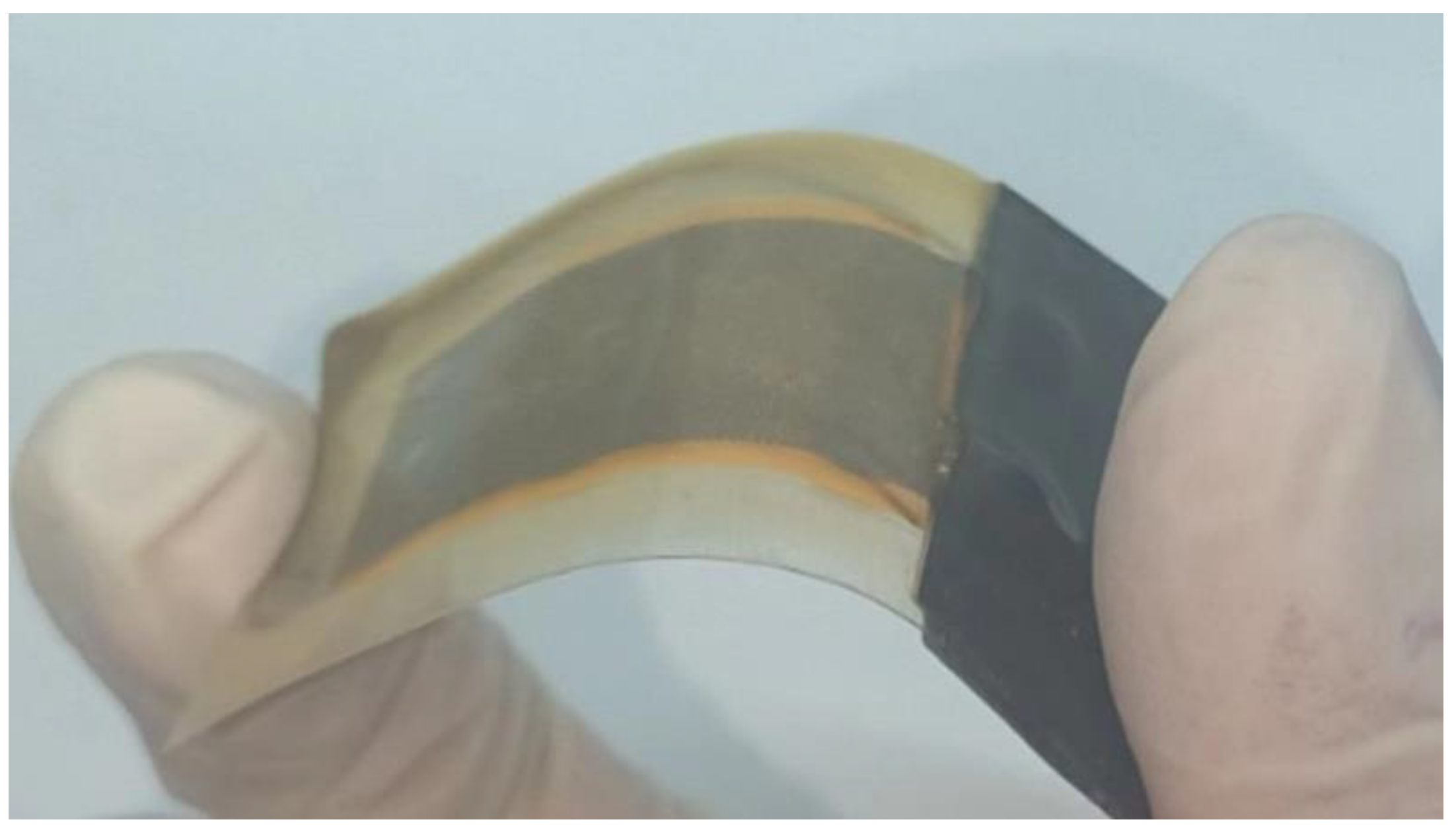
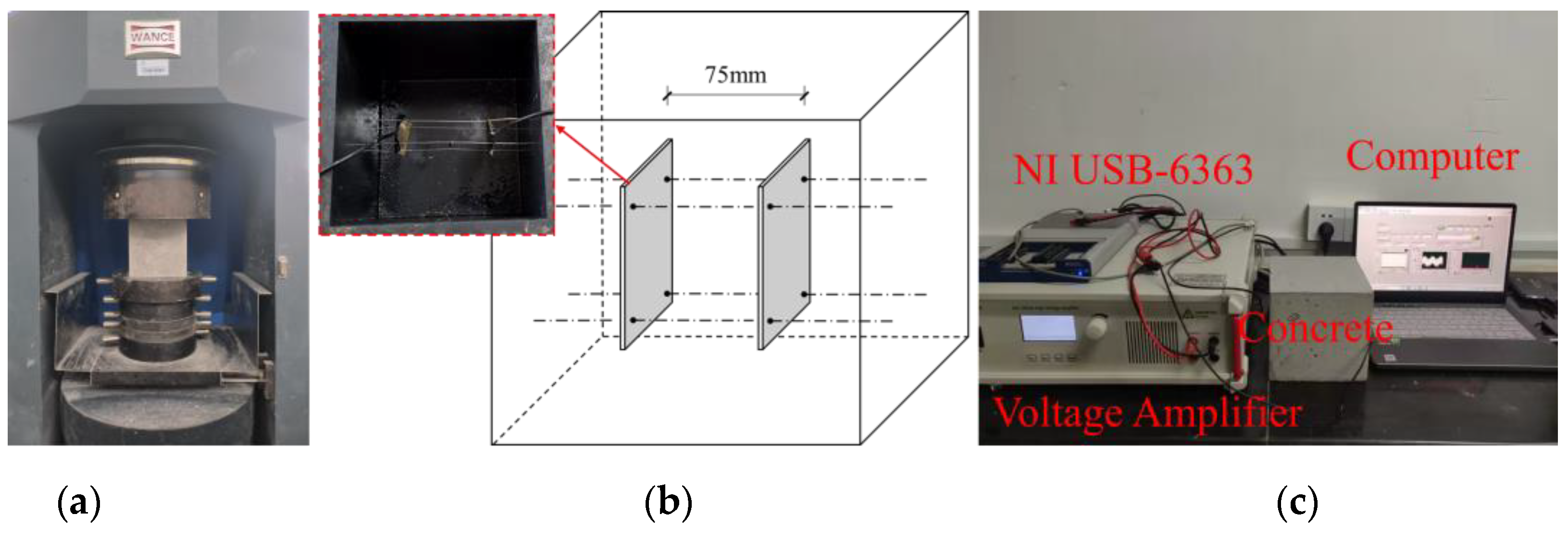
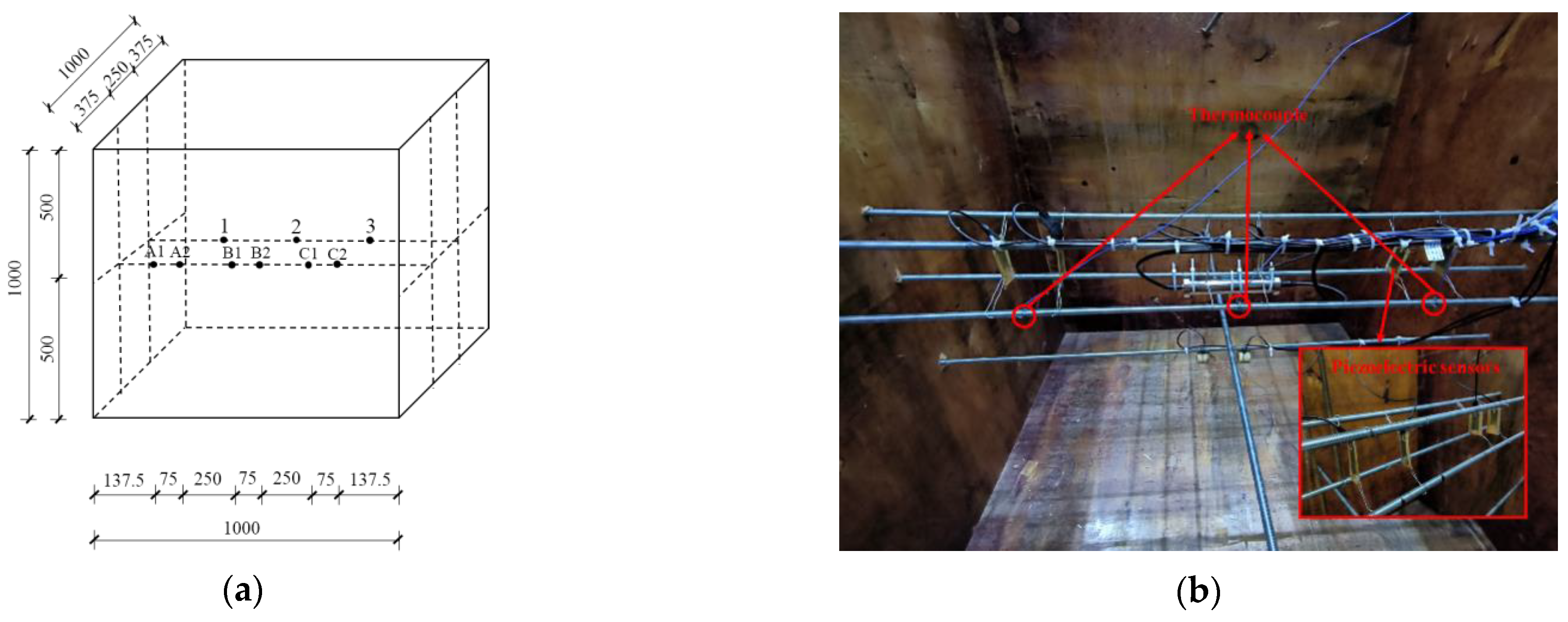

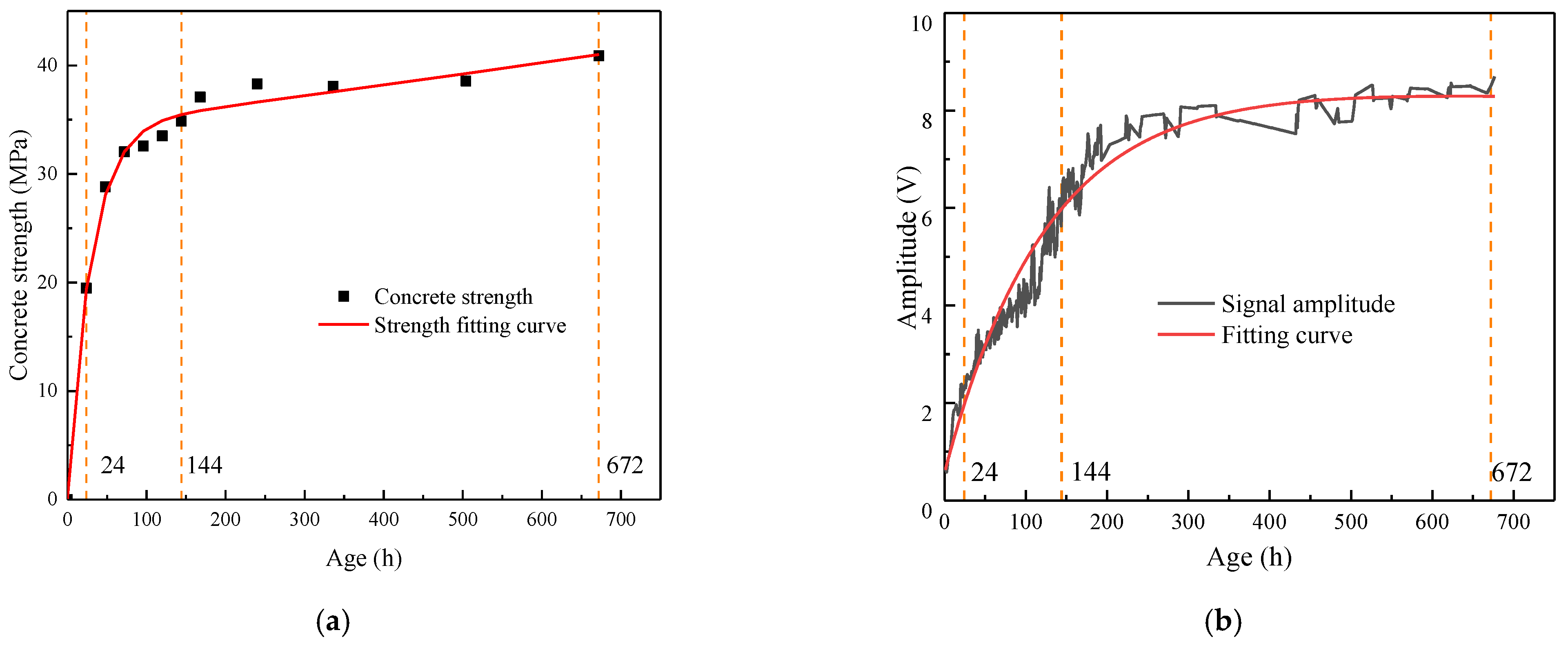

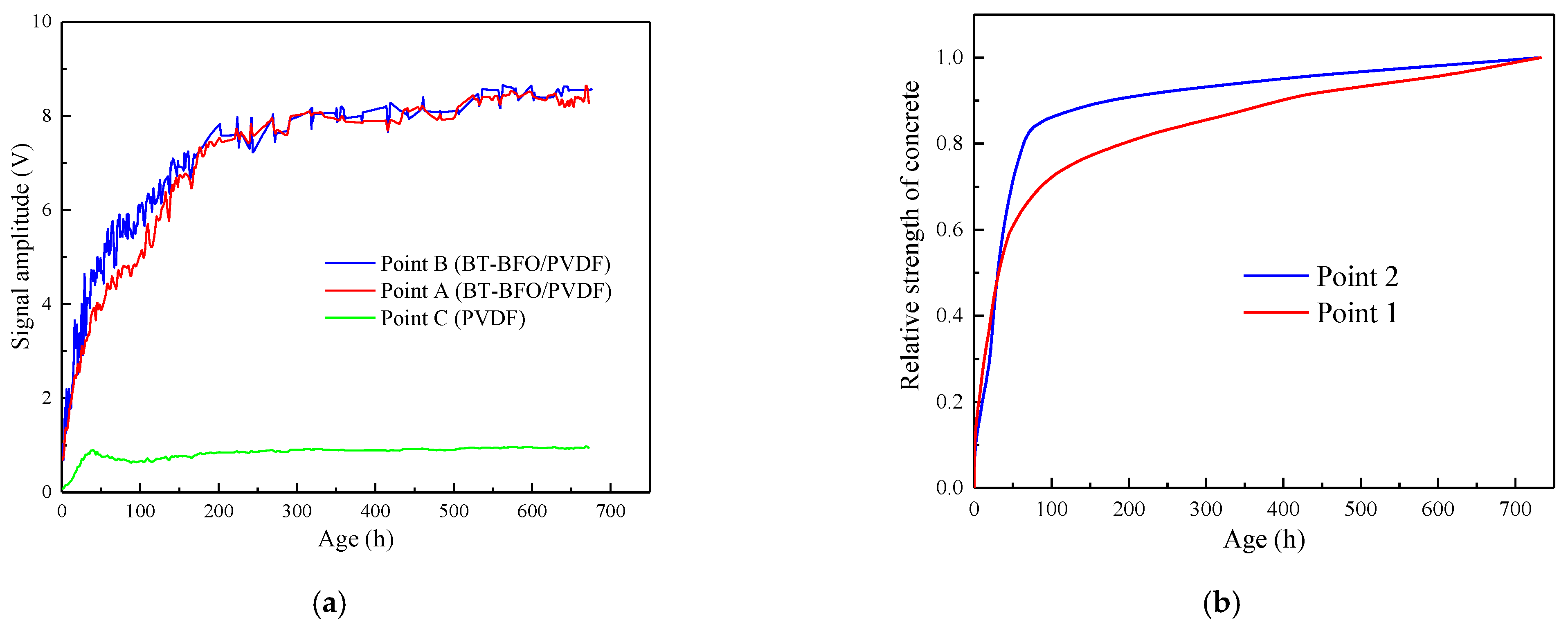
| Strength Grade | Cement | Water | Fine Aggregate | Coarse Aggregate |
|---|---|---|---|---|
| C40 | 436 | 220 | 542 | 1152 |
| Fitting Function | Correlation Coefficient (R) | a | b | c |
|---|---|---|---|---|
| y = a × ln(b × x) + c | 0.9801 | 0.3285 | 0.157589 | 1.5667 |
Disclaimer/Publisher’s Note: The statements, opinions and data contained in all publications are solely those of the individual author(s) and contributor(s) and not of MDPI and/or the editor(s). MDPI and/or the editor(s) disclaim responsibility for any injury to people or property resulting from any ideas, methods, instructions or products referred to in the content. |
© 2024 by the authors. Licensee MDPI, Basel, Switzerland. This article is an open access article distributed under the terms and conditions of the Creative Commons Attribution (CC BY) license (https://creativecommons.org/licenses/by/4.0/).
Share and Cite
Lin, G.; Lu, D.; Cui, B.; Lin, A.; Liu, M.; Ye, Y. Establishment of a Mass Concrete Strength-Monitoring Method Using Barium Titanate–Bismuth Ferrite/Polyvinylidene Fluoride Nanocomposite Piezoelectric Sensors with Temperature Stability. Sensors 2024, 24, 4653. https://doi.org/10.3390/s24144653
Lin G, Lu D, Cui B, Lin A, Liu M, Ye Y. Establishment of a Mass Concrete Strength-Monitoring Method Using Barium Titanate–Bismuth Ferrite/Polyvinylidene Fluoride Nanocomposite Piezoelectric Sensors with Temperature Stability. Sensors. 2024; 24(14):4653. https://doi.org/10.3390/s24144653
Chicago/Turabian StyleLin, Guoliang, Dongwang Lu, Bowen Cui, Aoxiang Lin, Minyi Liu, and Yongbin Ye. 2024. "Establishment of a Mass Concrete Strength-Monitoring Method Using Barium Titanate–Bismuth Ferrite/Polyvinylidene Fluoride Nanocomposite Piezoelectric Sensors with Temperature Stability" Sensors 24, no. 14: 4653. https://doi.org/10.3390/s24144653




